Flexible connection for the mixer: how to choose + install a bellows connection for water
To connect water heating equipment, toilets, faucets and other plumbing devices, a liner is required that will connect them to the water supply. This element can have a flexible or rigid design.
Most users prefer the first option. This choice is not made without reason - the flexible connection for the mixer is compact, practical and easy to install. Are you planning to purchase and install such a device, but doubt your own abilities?
We will help you solve this problem. The article describes the features of different types of flexible hoses, indicates the specifics of their application and provides practical advice on choosing the appropriate option. In addition, we have prepared detailed instructions for installing the faucet connection.
The content of the article:
Features of flexible plumbing connections
Unlike rigid fixtures, the liner, equipped with a movable design, can be easily installed in hard-to-reach places with limited space.
Main advantages of the products
During the labor-intensive installation process, steel pipes are bent and secured with clamps, resulting in a bulky metal structure. Installation of a flexible product is much simpler, while the overall quality and reliability of the entire system remains high.
The device is a durable elastic hose with a length of 0.3 to 5 meters.Fasteners with rubber sealing rings are inserted at the ends on both sides.
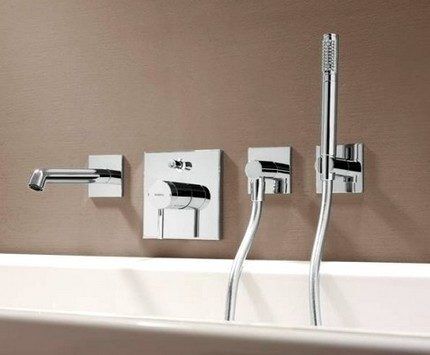
Typically, well-known faucet manufacturers equip their equipment with this type of connector, which is justified by a huge number of advantages.
Main advantages of the products:
- convenient and safe operation;
- sealed design made of high quality materials;
- the installation/disassembly process is simple for an inexperienced user and does not require specific knowledge, skills and professional equipment;
- resistance to vibrations and the effects of hydraulic shocks that periodically occur in the pipeline;
- long period of serviceable service subject to correct operating conditions;
- maintaining normal performance over a wide temperature range.
If necessary, flexible hoses move freely relative to the mixer and other plumbing fixtures, which cannot be said about their counterparts.
If you perform such manipulations carefully, you do not have to worry about accidental damage to the structure.
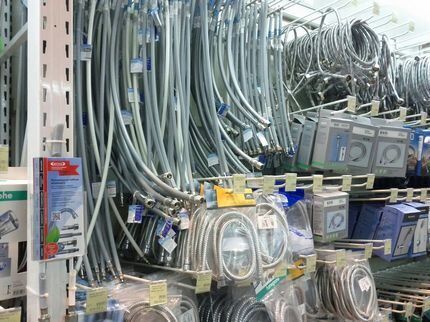
Of course, the listed advantages apply only to high-quality products. To purchase a hose with good technical characteristics, you should pay attention to products from reliable brands.
For example, Tucai, Mateu, Uni-Fitt. These manufacturers provide a guarantee for their products and have sanitary permits for contact of devices with drinking water. Companies are popular among domestic manufacturers Monolith, Flexiline, Aquatechnics.
Negative aspects of the device
Elastic hoses, although they are the optimal way to supply water, are not without drawbacks.
Based on the results of the analysis of consumer reviews taken from thematic forums and social networks, the following negative nuances were highlighted:
- products are afraid of excessive twisting, tension, kinks, which provoke irreversible deformation of the structure and greatly reduce the service life;
- if there is an open fire source near the intended installation site, installation of a flexible hose is prohibited;
- When water is simultaneously supplied to several rooms, vibrations occur in the bellows tubes, causing a characteristic hum.
The metal elements present in the device oxidize over time, which leads to the onset of corrosion processes.
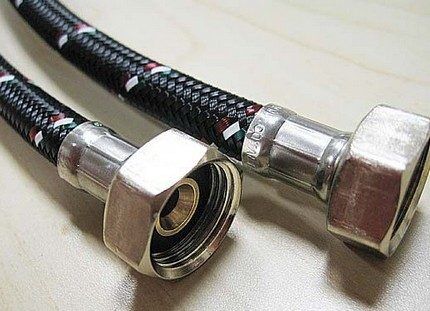
It should also be taken into account that certain types of flexible liners are sensitive to critical temperatures. Water that is too hot and close to boiling can damage the device, causing unwanted leaks and flooding.
Types of eyeliner: characteristics and specifics of application
Elastic hoses for faucets are divided into two categories: reinforced braided hoses and bellows tubes. Let's look at the features of each type of product in more detail.
Flexible hoses with reinforced braid
The first type of liner is a soft hose with high elastic properties, reinforced with a special braid.
The ends of the tube are equipped with fittings, with the help of which the structure is attached to the mixer: on one side there is a fitting, on the other there is a union nut with a certain diameter of the external thread. Reinforced devices have an affordable price, so they are most in demand among buyers.
Despite the simple production technology, the structure of the hoses is quite complex. The base consists of rubber, rubber or cross-linked polyethylene (PEX).
Experts say that in systems that supply drinking water, the use of rubber hoses is undesirable. The entire length of the product is braided with wire thread. Various materials are used to make braiding.
Stainless steel. The most common type of winding for reinforced hose. It is characterized by optimal operating parameters of the average level: the device functions perfectly within 10 atm. pressure and +95°C of the liquid passing through it. Stainless steel devices operate stably for up to 10 years.
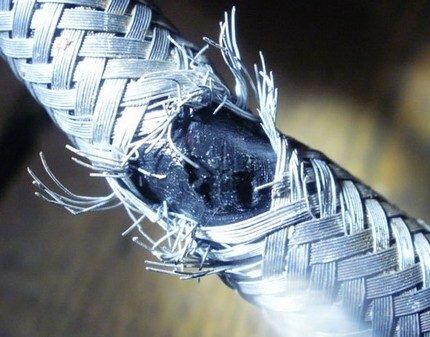
Nylon. The material has improved performance characteristics. Eyeliners with nylon braid are maximally functional: they can withstand up to +110°C and up to 20 atm. pressure. Their service life significantly exceeds their analogues and is usually at least 15 years.
Aluminum braid suitable only for those systems where the water temperature does not exceed +80°C and the operating pressure does not exceed 5 atm. This material is susceptible to corrosion, so it is better to use it in rooms with low humidity. Flexible hoses reinforced with aluminum braid do not require replacement for about 5 years.
Bellows tubes for water
The second type of liner is represented by bellows hoses. The durability and reliability of these models is much higher than reinforced products. The devices are distinguished by their unusual design, which gives them excellent flexibility.
It consists of stainless steel assembled into alternating rings of different diameters. At the initial stages of production, the hose blank is selectively crimped, resulting in a movable corrugated shape.
The bellows liner for water supply can be foldable or have a fixed length. The first option stretches within the range established by the manufacturer: from 200 to 355 mm, from 140 to 250 mm, etc.
Care must be taken when handling collapsible hoses, as excessive stretching will shorten the service life. Fixed length eyeliner cannot be stretched. It is produced in a specifically designated size: from 20 to 80 cm (in increments of 10 cm).
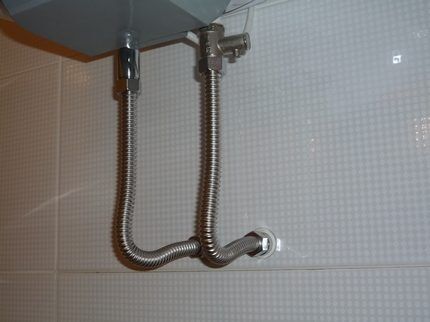
Bellows hoses have a common disadvantage - noise when supplying water to several consumers at once. The problem is relevant when, for example, water is supplied to the boiler, toilet and faucet at the same time.
To eliminate this, experts recommend choosing a liner with an insulating plastic coating. In addition, there are special anti-vibration modifications that absorb sound.
Basic criteria for product selection
A few simple recommendations will help you choose a faucet liner that is suitable in all respects and will last for years without any problems.
Before purchasing a product, experts advise:
- Check the compliance of the actual operating temperature parameters, pressure in the apartment water supply or private house with the technical characteristics of the eyeliner indicated on the label and in the manufacturer's instructions.
- Consider future operating conditions when selecting braiding material. For damp rooms with poor ventilation systems, you should not purchase products with metal braiding. Condensation that will settle on its surface will quickly lead to corrosion and damage the device.
- Estimate the weight of the product. There is a high probability that the hoses are too light and are made of aluminum and low-grade metals that quickly deteriorate during operation.
- Make sure there are no strong chemical odors. They indicate the use of hazardous technical rubber in the product.
- Test the eyeliner for elasticity. Insufficiently flexible, “oak” tubes will quickly crack and burst a short time after installation.
One of the main components of a hose is the fittings. They must be examined carefully. It is important that they are well pressed and have no visible defects.

Optimal materials for nuts are nickel-plated brass and stainless steel. Aluminum is absolutely not suitable for water supply. Also, do not buy eyeliners with flimsy plastic fittings.
When choosing a device, they are guided by the type of connection to the water supply and mixer, the type/dimensions of the threaded connection, and the length of the hose.
The thread can be internal or external with dimensions ranging from 0.5 to 1.5 inches. This parameter is coordinated with the holes in the pipe and device to which the hose will be connected.
For sinks, shower stalls and sinks, it is better to consider liners with a diameter of at least 10 mm. The required length is determined based on the distance between the plumbing fixture and the pipe outlet.
It is considered ideal if, after connecting, no unnecessary stress is created on the hose and no additional bends are formed.
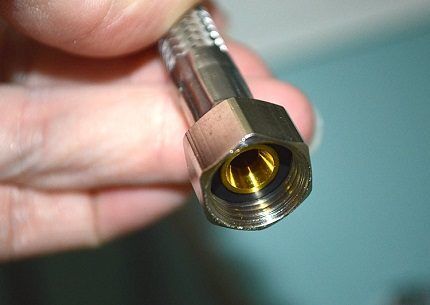
Instructions for connecting the liner
It is not at all necessary to involve specialists to install flexible hoses. You can cope with this simple process on your own, spending a few minutes. The hose is installed not only for new, but also for already used faucets.
Replacing the device is extremely necessary in two cases:
- the eyeliner is severely deformed or burst;
- Leaks have appeared in the connection area with the mixer and pipeline due to wear or damage to the gasket and union nut.
The installation procedure for connecting bellows and reinforced liners is identical.The first thing you need to check is whether the integrity of the product and fittings has been damaged during transportation and storage.
You should then take precautions by completely turning off the hot and cold water valves in the water supply. To drain the remaining liquid, you need to open the tap.
For installation/disassembly you will need a wrench or an adjustable wrench, which is selected to match the diameter of the union nut. Using a wrench, remove the part of the old hose connected to the water supply. Water may spill out of it, so place containers under the fastening points in advance.
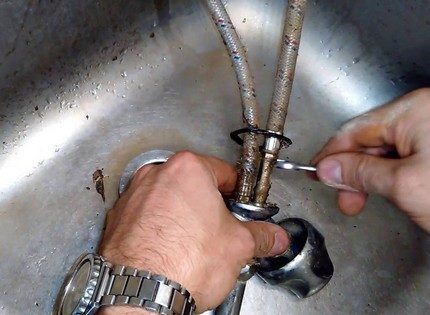
After disconnecting the hose from the water pipe, you need to remove the mixer by loosening the fixing nuts. Next, using the same key, you should disconnect the water supply from the mixer.
The new device is connected in the reverse order. At first, the nut is tightened by hand, then tightened with a wrench.
If the hose and faucet connectors do not mate, you can use additional adapters. The tightness of such connections is ensured by linen thread or FUM tape.
When installing the product, you should adhere to several rules:
- straighten the hose before installation, avoiding kinks;
- screw the flexible tube to the outlet and mixer without using excessive force;
- perform fastening in such a way that it is easy to get to the installation site for the purpose of preventive inspection (recommended inspection frequency is once every 6-12 months);
- connect pairs of parts made of similar materials to prevent the development of electrochemical corrosion; brass + copper is also suitable.
The final stage of installation includes mandatory testing of the connected structure. To check the tightness and capacity of the hose, the water supply is connected, after which the functionality of the device is assessed for half an hour.
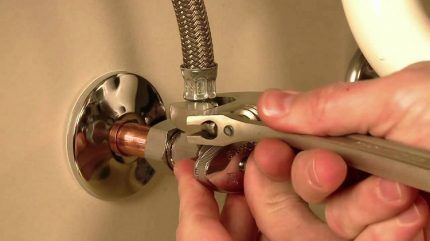
If you find any collecting drops at the fastening points, you need to tighten the nuts again with a wrench. If everything is in order, then the hose is ready for full use.
Any line connected to the water supply is constantly subject to stress. Because of this, there is always a possibility that the flexible tube may burst, unable to withstand the stress in the system.
To avoid having to correct the serious consequences of flooding, it is advisable to turn off the water supply taps when leaving the house for a long time. A good solution is to use anti-flood systems.
Wear or damage to the liner is far from the only cause of faucet breakdowns.
More information about possible crane malfunctions and how to eliminate them is written in the articles:
- Repairing a kitchen faucet with your own hands: installing taps + frequent breakdowns and how to fix them
- Repairing a single-lever mixer with your own hands: step-by-step instructions
- How to repair a ball mixer: a review of popular breakdowns and how to fix them
- How to repair a faucet in a bathroom with a shower: causes and solutions for breakdowns
Conclusions and useful video on the topic
How to choose the right eyeliner:
More information about installing flexible hoses for faucets:
Review of individual device models and analysis of factors influencing the service life of products:
Convenient and practical flexible devices are stubbornly pushing their competitors in the form of rigid metal pipes into the background. They are easy to install, quickly replaced, and do not require special care.
However, you should not try to save money on such a purchase: products of dubious quality can entail significant financial losses in the future.
Share with readers your experience in selecting and connecting flexible hoses to the mixer. Please leave comments, ask questions about the topic of the article and participate in discussions - the feedback form is located below.




I have heard the opinion that such flexible wiring is afraid of pressure surges. Do they have this problem or not?